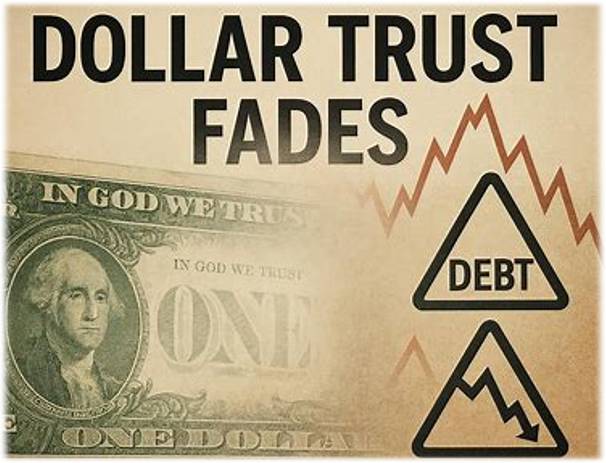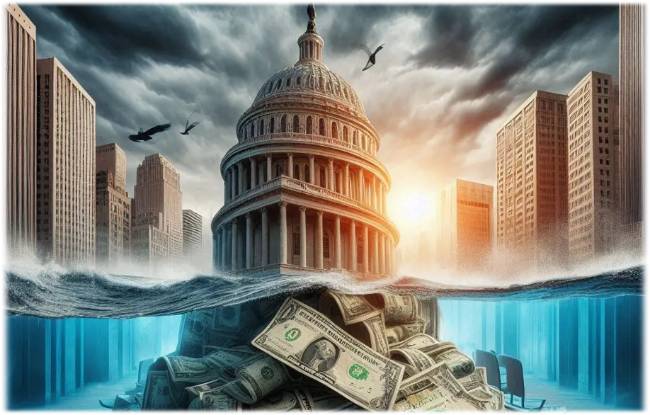Dollar Trust Fades Amid Debt and Market Warnings
Disclaimer: The information in this article is for educational purposes only. It is factual but does not constitute financial, legal, or investment advice. Readers should consult professionals for decisions.
By Doug Young – 24 August 2025
Introduction
The global economic and geopolitical landscape in 2025 is marked by increasing complexity and risk.
Central to this turbulence is the eroding trust in the U.S. dollar, the world’s primary reserve currency, amid unprecedented levels of national debt and emerging warning signs in financial markets.
U.S. National Debt: Scale and Implications
Current Debt Levels and Recent Trends
As of August 2025, the U.S. national debt has soared to approximately $37 trillion, according to the most recent Treasury and Joint Economic Committee data.
This represents a significant increase of more than $10 trillion compared to five years ago, with the debt growing at an average rate of over $5 billion daily.
This translates to roughly $108,000 of debt per American citizen and over $279,000 per household, underscoring the magnitude of fiscal obligations against the backdrop of a population nearing 340 million.
The national debt now surpasses the country’s gross domestic product (GDP), standing at about 119% of GDP, a post-World War II high. This means the total government debt exceeds the value of all goods and services produced annually in the U.S., a worrisome threshold that economists monitor closely.
Causes of Debt Growth
Several factors contribute to this unsustainable ascent.
Large federal budget deficits arise when annual government spending surpasses revenues. Key drivers include rising expenditures on social programs like Social Security and Medicaid, increased interest payments on accumulated debt, and extensive fiscal policies enacted in recent years that expanded government obligations without equivalent revenue increases.
The combination of these factors continues to widen the structural deficit, locking in higher future debt levels.
Consequences of Rising Debt
The consequences of such fiscal imbalance are profound.
Unsustainable debt levels can hamper long-term economic growth by crowding out investment and limiting government flexibility to respond to emergencies or economic downturns.
Higher debt servicing costs consume an increasing share of federal budgets, leaving less room for essential services and infrastructure.
Additionally, mounting debt raises concerns about financial market confidence and the willingness of investors to continue financing government borrowing at favorable rates.
Market Conditions and Warning Signs
Credit and Lending Risks
The consumer side of the economy shows signs of strain.
Subprime auto loan delinquencies have climbed to record highs, surpassing levels observed during the 2008 financial crisis. This signals financial stress for households reliant on credit to meet basic transportation needs.
Coupled with this, credit markets display extremely narrow lending spreads, reflecting excessive risk-taking and assumptions of continued economic stability that history warns may be dangerous.
Stock Market Concentration and Valuations
Financial markets exhibit precarious concentration risks.
Seven leading technology companies now account for nearly one-third of the S&P 500 index’s total market capitalization, a record concentration reminiscent of past market bubbles.
Valuation metrics, such as the price-to-book ratio, have reached historic highs compared to traditional benchmarks, increasing the vulnerability of markets to a sharp correction.
The rising dominance of passive investment strategies exacerbates this as it fuels momentum buying rather than fundamental value assessment.
Federal Reserve’s Liquidity Buffer Decline
A critical stabilizing mechanism in the U.S. financial system has weakened.
The Federal Reserve’s reverse repurchase facility, which historically has acted as a liquidity buffer to absorb shocks and maintain market stability, has contracted by 97% over the past two years.
This reduction decreases the system’s ability to manage liquidity stresses effectively, making banking reserves and credit conditions more susceptible to volatility during economic and financial disturbances.
Geopolitical and Economic Context
Impact of Sanctions and Tariffs
Tariffs imposed as part of trade policy act as a hidden tax on American consumers.
Meanwhile, international sanctions, particularly related to Russia, have had complex effects: they have bolstered domestic support for leadership in sanctioned countries while straining European economies and eroding global trust in financial institutions due to frozen sovereign assets.
Erosion of the Dollar’s Global Reserve Currency Status
The U.S. dollar’s unique status as the world’s primary reserve currency depends significantly on America’s economic power, political stability, and financial market depth.
Rapid debt accumulation, geopolitical uncertainties, and protectionist trade policies are straining that confidence. Unlike previous transitions spanning decades—from sterling to dollar—the current landscape lacks a clear alternative to the dollar.
Many emerging market central banks are diversifying reserves into non-dollar assets, primarily gold, to hedge against potential dollar devaluation and systemic risks in the global financial order.
The Role of Gold and Precious Metals
Central Banks’ Increasing Gold Purchases
Central banks worldwide have accelerated their gold purchases, acquiring gold at rates unseen for decades.
Bolivia exemplifies this trend by monetizing local gold reserves to raise approximately $3 billion, a practical measure in times when access to dollars and traditional financing becomes constrained.
These purchases represent prudent diversification strategies amid waning faith in fiat currencies.
Gold as a Store of Value Amid Uncertainty
Unlike financial instruments dependent on counterparty risk or the solvency of governments, gold has intrinsic value not tied to promises or liabilities.
This makes it a barometer of systemic stress and a preferred asset during periods when trust in currencies like the dollar declines.
Broader Implications for Individuals and Policymakers
Economic Realities Versus Illusions
There is a growing disconnect between economic narratives and underlying realities.
Debt is often portrayed as manageable growth fuel, market bubbles are assumed sustainable, and defaults are downplayed.
These illusions obscure the fundamental vulnerabilities that threaten economic stability and highlight the need for more sober public discourse and policymaking grounded in fiscal prudence.
Calls for Policy Reforms and Bipartisan Solutions
Experts largely agree on the necessity for bipartisan efforts aimed at long-term fiscal sustainability.
This includes reforming entitlements, rationalizing spending, and ensuring revenues align more closely with government obligations.
Safeguarding financial market stability through regulatory oversight and prudent monetary policies is equally imperative.
Understanding Geopolitical Stakes
Geopolitical dynamics, influenced by entrenched interests such as the military-industrial complex, complicate prospects for peace and stability.
Diplomatic strategies must balance power realities with economic interdependencies, particularly as the world transitions toward a multipolar system.
Clarity and restraint in foreign policy, coupled with economic cooperation, are needed to reduce tensions that risk exacerbating financial and geopolitical shocks.
Conclusion
The confluence of soaring debt, fragile financial markets, and geopolitical uncertainties is undermining trust in the U.S. dollar and global economic stability.
While these challenges are complex and unfolding, understanding their scope and implications is crucial. Responsible awareness and informed dialogue remain the best tools for navigating this precarious environment.
Disclaimer: The information in this article is for educational purposes only. It is factual but does not constitute financial, legal, or investment advice. Readers should consult professionals for decisions.










